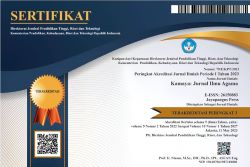Seni Sakral dan Sekuler Suatu Problema Dalam Kehidupan Sosial Religius: Perspektif Yadnya Umat Hindu di Bali
DOI:
https://doi.org/10.37329/kamaya.v3i1.377Keywords:
Sacred and Social Religious Perspective Yadnya in BaliAbstract
Art in the Hindu perspective in Bali have a very basic position, because it can not be separated from the Hindu community relegius. Ceremony in pretending (holy place) also can not be separated off from the arts such as singing, dancing, musical, painting, art, and literature. Temples, temples and the others are built in such a way as an expression of aesthetics, ethics, and attitudes of the people relegius Hindus in Bali. Pragina or dancers in a spirit of selfless ngayah or work offered various forms of art as a form of devotion presented to Ida Sang Hyang Widhi Wasa (God Almighty). In it there is a sense of devotion and dedication as a form of longing wanted to meet with the source of art itself and the artist wanted to be one with it because the real art of every human being in this world is the spark of art.. The research method used in this research is the Study of Literature. Literature study is research conducted by collecting information from various sources such as books, theses, theses, journals and others to answer and describe the problem formulation in a study. The purpose of this study is to study the Sacred and Secular Arts in Problems in Religious Social Life: The Perspective of Yadnya Hindus in Bali.
References
Bandem, I. M. (1981). Kaja and Kelod Balinese Danche in Transtition. Kualalumpur: Oxford University.
Himawan, W., Sabana, S., & Kusmara, A. R. (2016). Pengaruh Pariwisata pada Keberagaman Seni Rupa sebagai Modal Kultural Bali: Studi pada Komunitas dan Perhelatan Seni Rupa di Wilayah Denpasar, Klungkung, dan Singaraja. Journal of Urban Society’s Arts. https://doi.org/10.24821/jousa.v3i2.1478
Karawitan, J. (2018). Angsel-Angsel dalam Gong Kebyar I Ketut Yasa. Jurnal Seni Budaya. https://doi.org/10.25126/jtiik.
Koentjaraningrat. (2003). Pengantar Antropologi I. Jakarta: Rineka Cipta.
Maharlika, F. (2011). Tinjauan Bangunan Pura Di Indonesia. Jurnal Waca Cipta Ruang.
Ngurah Seramasara, I. G. (2017). Perubahan Kreativitas Seni Sebuah Proses Simbolis Dalam Kategori Sejarah. MUDRA Jurnal Seni Budaya.
Ni Nyoman Karmini. (2017). Fungsi Dan Makna Sastra Bali Tradisional Sebagai Pembentuk Karakter Diri. MUDRA Jurnal Seni Budaya.
Noorwatha, I. K. D., & Wasista, I. P. U. (2019). Rasayatra: Eksplorasi Estetika Hindu ‘Nawarasa’ dalam Desain Interior Museum 3D Interactive Trick Art. Mudra Jurnal Seni Budaya. https://doi.org/10.31091/mudra.v34i2.514
Rizali, N. (2003). SENI : Estetika, Logika, dan Etika. Jurnal Holistik.
Shamanisme: Fenomena Religius Dalam Seni Pertunjukan Nusantara. (2013). Harmonia - Journal of Arts Research and Education. https://doi.org/10.15294/harmonia.v13i2.2783
Suardana, I. W. (2018). Fenomena Upacara Yadnya Dan Judi Tajen Dalam Penciptaan Karya Seni Rupa. Mudra Jurnal Seni Budaya. https://doi.org/10.31091/mudra.v33i2.347
Suhaya. (2016). Pendidikan Seni Sebagai Penunjang Kreatifitas. Jurnal Pendidikan Dan Kajian Seni.
Triguna, I. B. . (2001). Redifinisi Simbolisme Masyarakat Hindu Di Bali (Laporan Penelitian). Denpasar.
Downloads
Published
How to Cite
Issue
Section
License
An author who publishes in the Kamaya : Jurnal Ilmu Agama agrees to the following terms:
- Author retains the copyright and grants the journal the right of first publication of the work simultaneously licensed under the Creative Commons Attribution-ShareAlike 4.0 License that allows others to share the work with an acknowledgement of the work's authorship and initial publication in this journal
- Author is able to enter into separate, additional contractual arrangements for the non-exclusive distribution of the journal's published version of the work (e.g., post it to an institutional repository or publish it in a book) with the acknowledgement of its initial publication in this journal.
- Author is permitted and encouraged to post his/her work online (e.g., in institutional repositories or on their website) prior to and during the submission process, as it can lead to productive exchanges, as well as earlier and greater citation of the published work (See The Effect of Open Access).
Read more about the Creative Commons Attribution-ShareAlike 4.0 Licence here: https://creativecommons.org/licenses/by-sa/4.0/.





